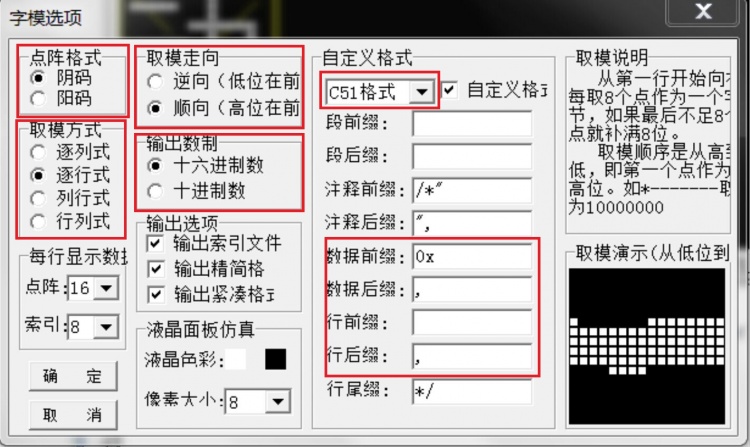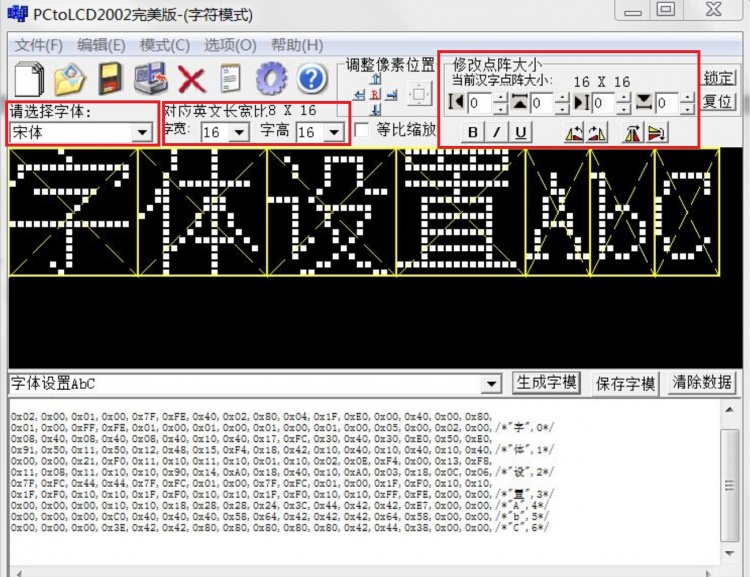Difference between revisions of "Chinese and English display modulo settings"
(→Bottom support function) |
|||
| Line 30: | Line 30: | ||
The function implementation differs depending on the driver IC (different drive ICs set coordinate values with different commands and principles), | The function implementation differs depending on the driver IC (different drive ICs set coordinate values with different commands and principles), | ||
| + | |||
but the principle is basically the same, setting the start and end coordinates and setting a display area. | but the principle is basically the same, setting the start and end coordinates and setting a display area. | ||
Revision as of 11:59, 26 November 2018
Molding software configuration
The font modulo software used in the test example is PCtoLCD2002. For detailed instructions on its use, see the following document:
PCtoLCD2002 Instructions for use
The PCtoLCD2002 software is specifically set as follows:
Font selection 宋体, the dot size offset is 0
Word width and word height are selected: 12x8, 16x16, 24x24, 32x32 (English corresponds to 6x8, 8x16, 12x24, 16x32)
Dot matrix format select 阴码
Modal mode select 逐行式
Molding trend select 顺向(高位在前)
Output number system select 十六进制数
Custom format select C51格式
Other by default
Bottom support function
*LCD_SetWindows
The function implementation differs depending on the driver IC (different drive ICs set coordinate values with different commands and principles),
but the principle is basically the same, setting the start and end coordinates and setting a display area.
Examples are as follows (ILI9341 as an example)
void LCD_SetWindows(u16 xStar, u16 yStar,u16 xEnd,u16 yEnd)
{
LCD_WR_REG(lcddev.setxcmd);
LCD_WR_DATA(xStar>>8);
LCD_WR_DATA(0x00FF&xStar);
LCD_WR_DATA(xEnd>>8);
LCD_WR_DATA(0x00FF&xEnd);
LCD_WR_REG(lcddev.setycmd);
LCD_WR_DATA(yStar>>8);
LCD_WR_DATA(0x00FF&yStar);
LCD_WR_DATA(yEnd>>8);
LCD_WR_DATA(0x00FF&yEnd);
LCD_WriteRAM_Prepare(); //开始写入GRAM
}
*Lcd_WriteData_16Bit
该函数就是往GRAM里面设置像素颜色值,然后显示出来
举例如下(ILI9341为例)
void Lcd_WriteData_16Bit(u16 Data)
{
LCD_CS_CLR;
LCD_RS_SET;
SPI_WriteByte(SPI2,Data>>8);
SPI_WriteByte(SPI2,Data);
LCD_CS_SET;
}
*LCD_DrawPoint
其实就是利用LCD_SetWindows函数和Lcd_WriteData_16Bit函数显示一个像素点
举例如下(ILI9341为例)
void LCD_DrawPoint(u16 x,u16 y)
{
LCD_SetCursor(x,y);//设置光标位置
Lcd_WriteData_16Bit(POINT_COLOR);
}
英文取模
函数定义如下:
void LCD_ShowChar(u16 x,u16 y,u16 fc, u16 bc, u8 num,u8 size,u8 mode)
{
u8 temp;
u8 pos,t;
u16 colortemp=POINT_COLOR;
num=num-' ';//得到偏移后的值
LCD_SetWindows(x,y,x+size/2-1,y+size-1);//设置单个文字显示窗口
if(!mode) //非叠加方式
{
for(pos=0;pos<size;pos++)
{
if(size==12)
{
temp=asc2_1206[num][pos];//调用1206字体
}
else
{
temp=asc2_1608[num][pos]; //调用1608字体
}
for(t=0;t<size/2;t++)
{
if(temp&(0x80>>t))
{
Lcd_WriteData_16Bit(fc);
}
else
{
Lcd_WriteData_16Bit(bc);
}
}
}
}
else//叠加方式
{
for(pos=0;pos<size;pos++)
{
if(size==12)
{
temp=asc2_1206[num][pos];// 调用1206字体
}
else
{
temp=asc2_1608[num][pos]; //调用1608字体
}
for(t=0;t<size/2;t++)
{
POINT_COLOR=fc;
if(temp&(0x80>>t))
{
LCD_DrawPoint(x+t,y+pos);//画一个点
}
}
}
}
POINT_COLOR=colortemp;
LCD_SetWindows(0,0,lcddev.width-1,lcddev.height-1);//恢复窗口为全屏
}
此函数包含了12x6和16x8两种英文字体设置。
包含了两种显示模式:叠加模式和非叠加模式。
叠加模式:字体不带背景色,直接叠加显示到原来显示的内容上
非叠加模式:字体带有背景色,显示时会将原来显示的内容覆盖掉
中文取模
A、16x16中文字体显示函数定义如下:
void GUI_DrawFont16(u16 x, u16 y, u16 fc, u16 bc, u8 *s,u8 mode)
{
u8 i,j;
u16 k;
u16 HZnum;
u16 x0=x;
HZnum=sizeof(tfont16)/sizeof(typFNT_GB16); //自动统计汉字数目
for (k=0;k<HZnum;k++)
{
if((tfont16[k].Index[0]==*(s))&&(tfont16[k].Index[1]==*(s+1)))
{
LCD_SetWindows(x,y,x+16-1,y+16-1);
for(i=0;i<16*2;i++)
{
for(j=0;j<8;j++)
{
if(!mode) //非叠加方式
{
if(tfont16[k].Msk[i]&(0x80>>j))
{
Lcd_WriteData_16Bit(fc);
}
else
{
Lcd_WriteData_16Bit(bc);
}
}
else
{
POINT_COLOR=fc;
if(tfont16[k].Msk[i]&(0x80>>j))
{
LCD_DrawPoint(x,y);//画一个点
}
x++;
if((x-x0)==16)
{
x=x0;
y++;
break;
}
}
}
}
}
continue; //找到对应点阵字库立即退出,防止多个汉字重复取模带来影响
}
LCD_SetWindows(0,0,lcddev.width-1,lcddev.height-1);//恢复窗口为全屏
}
B、24x24中文字体显示函数定义如下:
void GUI_DrawFont24(u16 x, u16 y, u16 fc, u16 bc, u8 *s,u8 mode)
{
u8 i,j;
u16 k;
u16 HZnum;
u16 x0=x;
HZnum=sizeof(tfont24)/sizeof(typFNT_GB24); //自动统计汉字数目
for (k=0;k<HZnum;k++)
{
if((tfont24[k].Index[0]==*(s))&&(tfont24[k].Index[1]==*(s+1)))
{
LCD_SetWindows(x,y,x+24-1,y+24-1);
for(i=0;i<24*3;i++)
{
for(j=0;j<8;j++)
{
if(!mode) //非叠加方式
{
if(tfont24[k].Msk[i]&(0x80>>j))
{
Lcd_WriteData_16Bit(fc);
}
else
{
Lcd_WriteData_16Bit(bc);
}
}
else
{
POINT_COLOR=fc;
if(tfont24[k].Msk[i]&(0x80>>j))
{
LCD_DrawPoint(x,y);// 画一个点
}
x++;
if((x-x0)==24)
{
x=x0;
y++;
break;
}
}
}
}
}
continue; //找到对应点阵字库立即退出,防止多个汉字重复取模带来影响
}
LCD_SetWindows(0,0,lcddev.width-1,lcddev.height-1);// 恢复窗口为全屏
}
C、32x32中文字体显示函数定义如下:
void GUI_DrawFont32(u16 x, u16 y, u16 fc, u16 bc, u8 *s,u8 mode)
{
u8 i,j;
u16 k;
u16 HZnum;
u16 x0=x;
HZnum=sizeof(tfont32)/sizeof(typFNT_GB32); //自动统计汉字数目
for (k=0;k<HZnum;k++)
{
if ((tfont32[k].Index[0]==*(s))&&(tfont32[k].Index[1]==*(s+1)))
{
LCD_SetWindows(x,y,x+32-1,y+32-1);
for(i=0;i<32*4;i++)
{
for(j=0;j<8;j++)
{
if(!mode) //非叠加方式
{
if(tfont32[k].Msk[i]&(0x80>>j))
{
Lcd_WriteData_16Bit(fc);
}
else
{
Lcd_WriteData_16Bit(bc);
}
}
else
{
POINT_COLOR=fc;
if(tfont32[k].Msk[i]&(0x80>>j))
{
LCD_DrawPoint(x,y);// 画一个点
}
x++;
if((x-x0)==32)
{
x=x0;
y++;
break;
}
}
}
}
}
continue; //找到对应点阵字库立即退出,防止多个汉字重复取模带来影响
}
LCD_SetWindows(0,0,lcddev.width-1,lcddev.height-1);// 恢复窗口为全屏
}
以上三个函数分别是对16x16、24x24、32x32汉字进行显示设置。
包含了两种显示模式:叠加模式和非叠加模式。
叠加模式:字体不带背景色,直接叠加显示到原来显示的内容上
非叠加模式:字体带有背景色,显示时会将原来显示的内容覆盖掉

